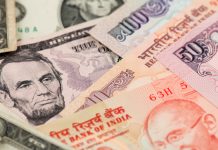- Indian Rupee (INR) trades water on Tuesday
- Risk appetite improves on China optimism
- US Dollar (USD) falls despite strong jobs data on Friday
- US ISM services PMI due
The US Dollar Indian Rupee (USD/INR) exchange rate is rising at the start of the week after small losses in the previous week. The pair fell -0.37% last week, settling on Friday at 81.41. Today, at 13:30, USD/INR trades +0.51% at 81.82, trading in a range between 81.20 to 81.87.
The Indian services sector grew at its fastest pace in 3 months in November according to the S&P global services PMI. The index rose to 56.4 in November, up from 55.1 in October. This was ahead of the 55.4 estimated.
Delving further into the data it showed that strong demand boosted optimism in the sector to an eight year high. Prices also rose at the fastest pace since July 2017. The sector is benefiting from strong domestic demand thanks in part to pent up demand. However, growth is likely to slow in coming quarters as interest rates rise.
The US Dollar is falling against its major peers. The US Dollar Index, which measures the greenback versus a basket of major currencies, trades at -0.05% at the time of writing at 104.46, marking the fifth straight day of losses.
The USD fell last week after Federal Reserve Chair Jerome Powell indicated that the US central bank would downshift the pace of interest rate hikes as from the December meeting. His comments pulled the US dollar sharply lower.
Not even Friday’s stronger than forecast non-farm payroll report has deterred the selloff in the USD. The US was 263,000 jobs added in November and the October headline figures was upwardly revised toto 284,000. Average hourly wages jumped 5.1% year on year up from 4.9% and unemployment held steady at 3.7%.
Today the focus will stay on economic data with the release of US ISM services PMI, which is expected to rise to 55.5 in November, up from 54.4, suggesting that they is still strong growth in the sector.
US factory orders are expected to rise 0.7% up from a 0.3% increase in September. Strong data could raise doubts over the amount the Federal Reserve can slow rate hikes





